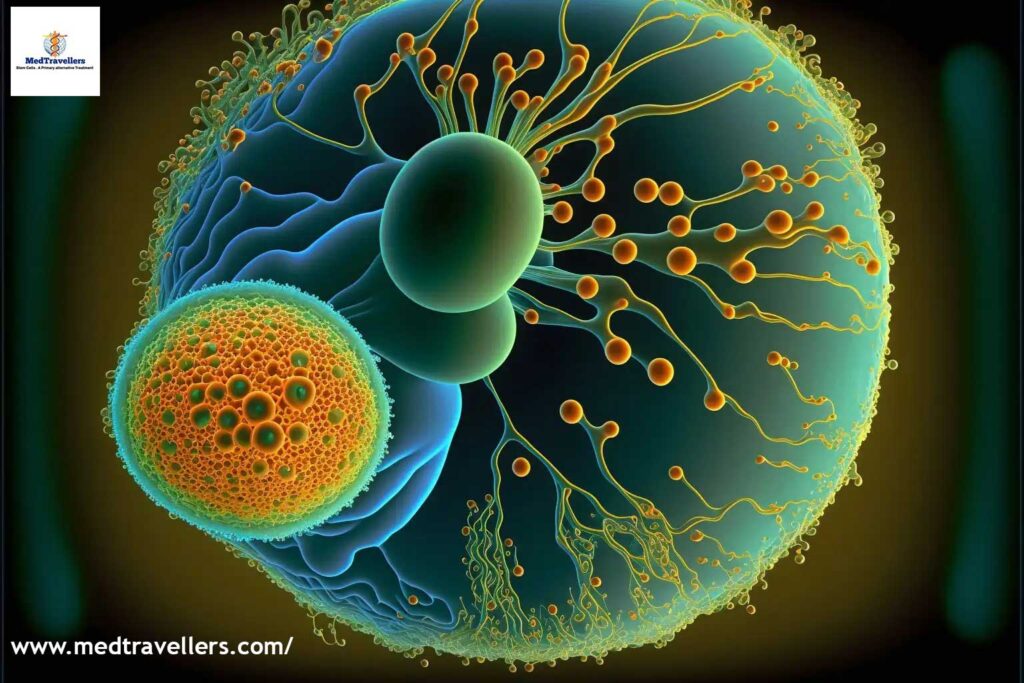Neuro Disorder
Organ Specfic
Orthopadic
Stem Cell Therapy
- Umbilical Cord Tissue Stem Cell
- Stem Cell Therapy Safety and Risks
- Mesenchymal Stem Cell Therapy
- Stem Cell Therapy Limitations
- Adipose Tissue diseases Stem Cell
- Bone Marrow Stem Cell
- Induced Pluripotent Stem Cell
- Why India for stem cell treatments?
- Stem Cell Treatment of ATAXIA in Delhi, India
- Limitations of Stem Cell Treatment

Stem Cell Therapy Safety and Risks
At MedTravellers, we take pride in giving our patients reliable and recent information concerning the benefits and risks that might come with stem cell therapy. With stem cell therapy being a fast-changing field in regenerative medicine, safety issues have to be thoroughly addressed given how promising such an approach is.
Essential safety measures are addressed in this article about safety considerations for stem cell therapy.
- Source and Quality of Stem Cells: One of the most essential aspects is the purity of the stem cells used in therapy, their origin, and whether they have been screened thoroughly for possible contaminants.
- Regulatory Oversight: It is mandatory that the organization should abide by FDA and EMA safety procedures and guidelines to ensure the best safety practices in the whole process.
- Clinical Trial Protocols: The patient protection during clinical trial activities is done by setting up and enforcing strict rules for patient safety and evaluation of treatment effectiveness.
- Long-term Follow-up: It is only through incessant monitoring of patients that the long-term effects and unforeseen complications of stem cell therapy can be discovered.
- Potential Risks and Side Effects Although much hope is placed on the stem cell therapy, the reader must take into consideration the hazards and side effects that come along with it.
- Immune Rejection: The immune system might envisage those foreign cells and hence trigger a response that will ultimately end in rejection of the transplant.
- Tumor Formation: There is a possibility that, in some rare cases, the stem cells that are grafted might cancerously grow and develop into tumors.
- Infection: A risk of infection is always there in the cell harvesting or transplantation procedure; however, it has to be minimized as much as possible.
- Unintended Differentiation: The stem cells can convert to the types of cells that are not the targeted ones, resulting in unexpected consequences.
- Migration: The transplanted cells can find their way to areas other than the intended ones, thus causing some problems.
- Contamination: Due to the nature of the cell processing or storage stages, there is a chance that contamination might happen.
- Unexpected Side Effects: Like any other form of medical treatment, the patient might experience side effects that were previously unforeseen, and they might also occur after some time has passed.
Stem cells have been successfully applied in medicine to solve problems of human health in different ways, such as:
- Neurological Disorders: The scientists are looking at stem cells with the idea that one day they will be enough to heal the damages caused by autism, Alzheimer’s disease, Parkinson’s disease, and amyotrophic lateral sclerosis (ALS).
- Autoimmune Disorders: Stem cells that have the property of immunomodulation might be used as an option for the treatment of diseases such as Type 1 Diabetes, Multiple Sclerosis, and Rheumatoid Arthritis.
- Cardiovascular Diseases: Treatment with stem cells is being considered for the purpose of mending the heart tissues that have been damaged and, as a result, providing better heart function.
- Orthopedic Injuries: Through regenerative medicine based on stem cells, some drugs are being formulated to rebuild and regenerate the parts of the bones, cartilages, and ligaments that are injured or weak.
Research in MedTravellers and Stem Cell Therapy in India A Future Treatment
We, at MedTravellers, understand that stem cell therapy is a highly dynamic field and that there are numerous breakthroughs coming up one after another. Though the development of these treatments in terms of the long-term safety profile and effectiveness is still at its initial stages, getting involved in the latest investigations and relaying the findings to our patients is what we have committed ourselves to.
As we persist in unfolding the extensive capability that stem cell methods have, it will be required to handle with care and reserve the safety risks while fully embracing the optimism for such treatments. We at MedTravellers take it upon ourselves to make sure that our patients are fully informed before making their decisions and at the time of their treatment of the highest quality.
FAQs
1. Is stem cell therapy safe?
Stem cell interventions hold immense potential in the field of regenerative medicine. However, their safety largely depends on the origin and standards of the cells, the skills of the medical team, and the compliance with the international medical guidelines.
2. What are the main risks of stem cell therapy?
Those who are considering stem cell therapy should be aware that various risks are associated with this treatment. The potential issues might be immune rejection, infection during the procedure, unplanned growth of cells or formation of the tumor, and side effects that sometimes take place only after some time.
3. Why is long-term follow-up important?
Long-term follow-up is essential, as it allows the doctors to monitor the patient’s reaction to the therapy, discover rare or late-onset side effects, and provide reassurance that the treatment is still safe and effective.
4. How do MedTravellers ensure patient safety?
MedTravellers take the safety of patients as the highest priority. To this end, they employ the use of rigorously tested stem cells, adhere to the most stringent international safety procedures, and keep their patients informed of not only the benefits but also the potential risks.



